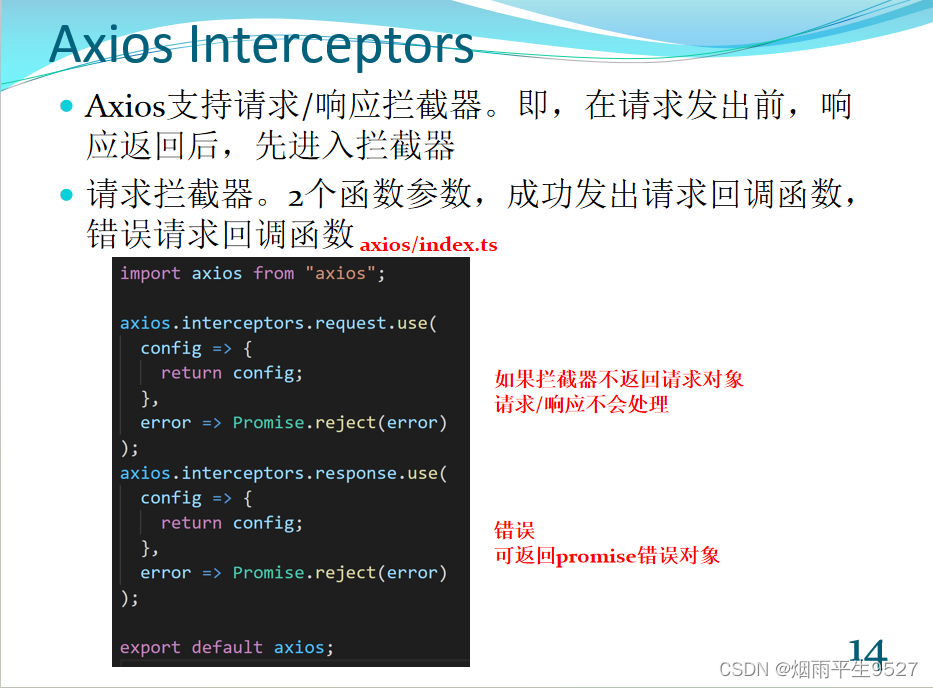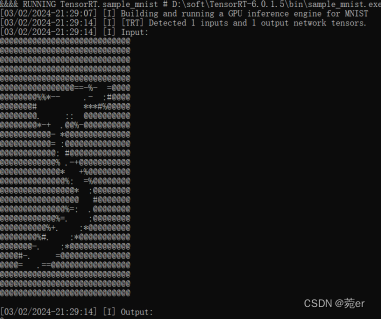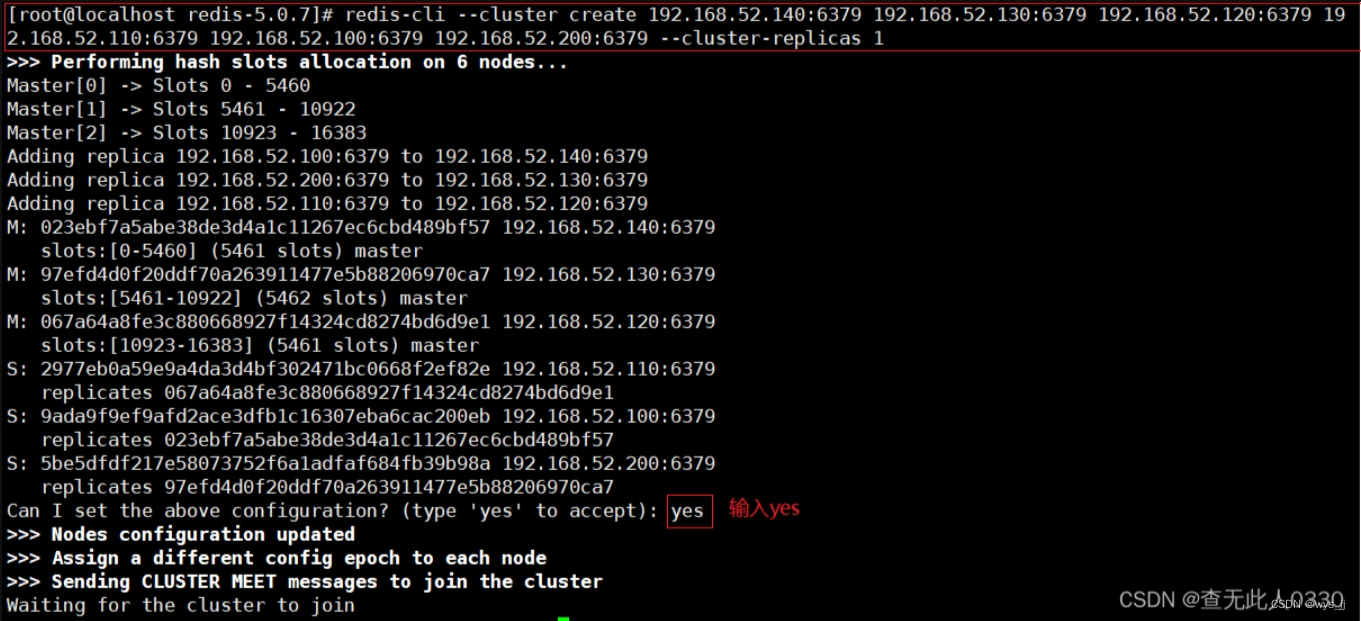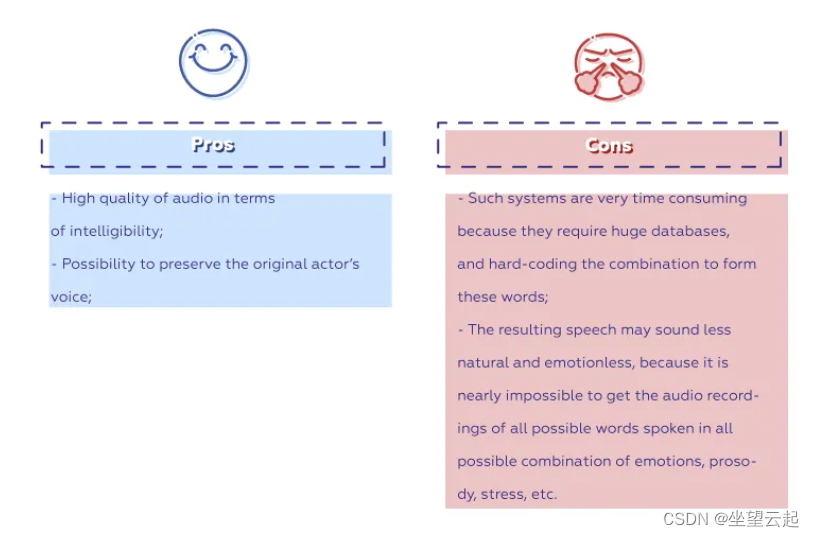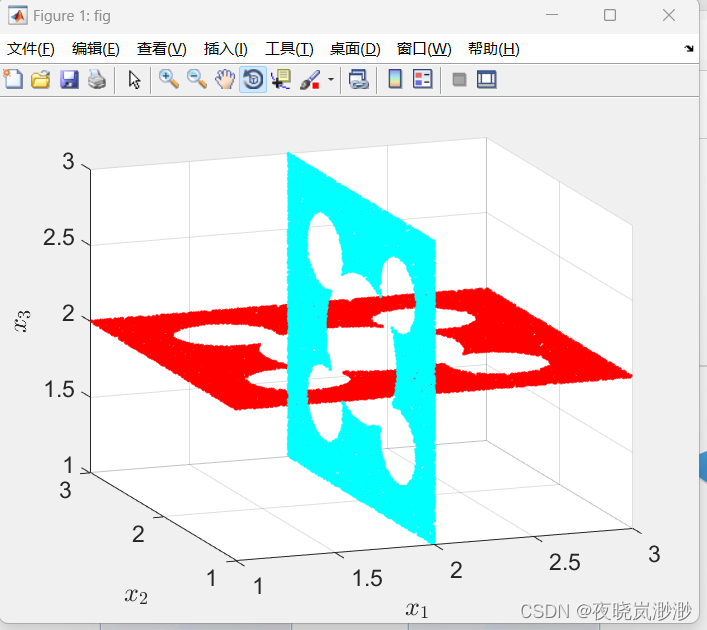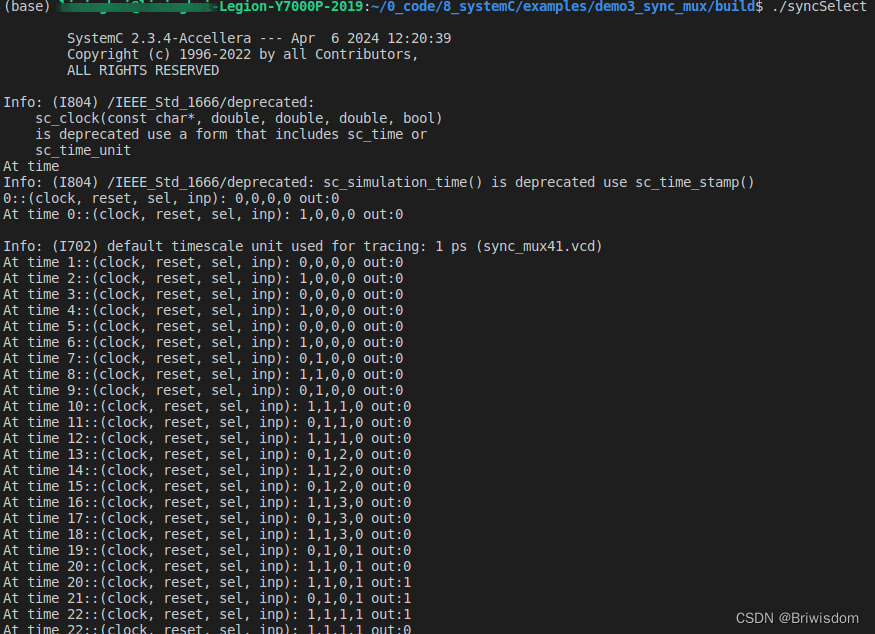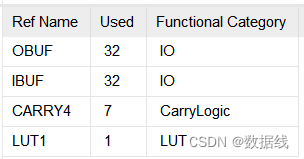一、环境配置
1.1概述
上古浏览器页面在向服务器请求数据时,因为返回的是整个页面的数据,页面都会强制刷新一下,这对于用户来讲并不是很友好。并且我们只是需要修改页面的部分数据,但是从服务器端发送的却是整个页面的数据,十分消耗网络资源。而我们只是需要修改页面的部分数据,也希望不刷新页面,因此异步网络请求就应运而生。
Ajax(Asynchronous JavaScript and XML):异步网络请求。Ajax能够让页面无刷新的请求数据。
实现ajax的方式有多种,如jQuery封装的ajax,原生的XMLHttpRequest,以及axios。但各种方式都有利弊
原生的XMLHttpRequest的配置和调用方式都很繁琐,实现异步请求十分麻烦
jQuery的ajax相对于原生的ajax是非常好用的,但是没有必要因为要用ajax异步网络请求而引用jQuery框架
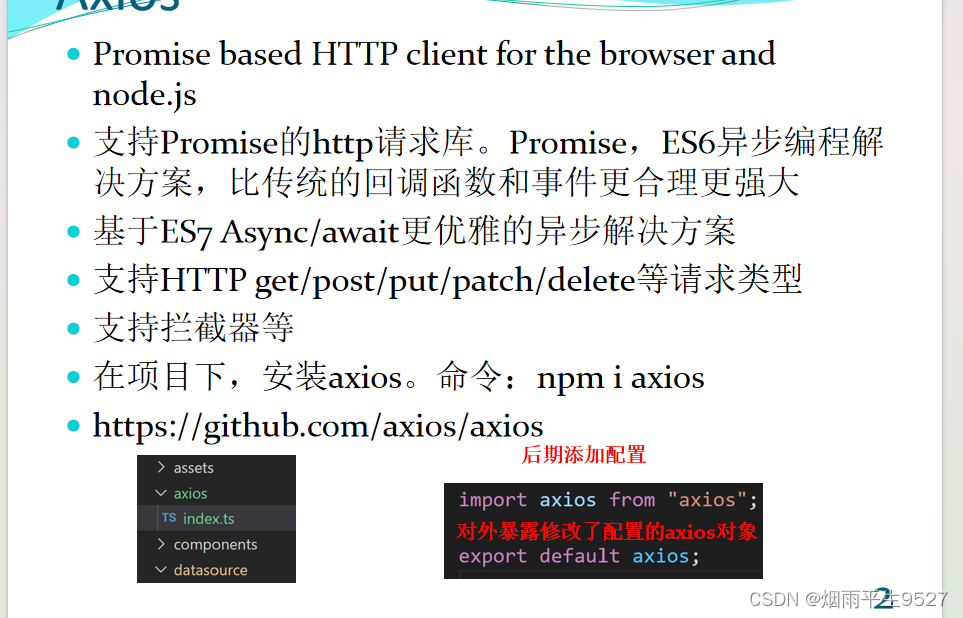
1.2安装
pnpm i axios --save-dev在项目中创建untils/request.js文件
import axios from 'axios'
// 创建可一个新的axios对象
const request = axios.create({
baseURL: 'http://localhost:9090', // 后端的接口地址 ip:port
timeout: 30000
})
// request 拦截器
// 可以自请求发送前对请求做一些处理
// 比如统一加token,对请求参数统一加密
request.interceptors.request.use(config => {
config.headers['Content-Type'] = 'application/json;charset=utf-8';
// let user = localStorage.getItem("user") ? JSON.parse(localStorage.getItem("user")) : null
// config.headers['token'] = 'token' // 设置请求头
return config
}, error => {
console.error('request error: ' + error) // for debug
return Promise.reject(error)
});
// response 拦截器
// 可以在接口响应后统一处理结果
request.interceptors.response.use(
response => {
let res = response.data;
// 兼容服务端返回的字符串数据
if (typeof res === 'string') {
res = res ? JSON.parse(res) : res
}
return res;
},
error => {
console.error('response error: ' + error) // for debug
return Promise.reject(error)
}
)
export default request1.3示例
import axios from "axios";
data() {
return {
users: []
}
}
mounted() { // 页面加载完成之后触发
axios.get('http://localhost:9090/user/selectAll').then(res => {
console.log(res.data) // 后台返回的数据
// res.data = { // 数据格式
// code: '200',
// msg: '请求成功',
// data: {
//
// }
// }
})
},
@CrossOrigin1.4相关文档
请求配置 | Axios中文文档 | Axios中文网
二、跨域资源访问
2.1会话存储
随着富客户端快速发展,普通本地存储(cookie)无法满足前端需要的大量数据的存储需求 HTML5,引入Web存储,Web应用程序可以在用户的浏览器中本地存储数据
- 包括本地数据库技术 IndexedDB/WebSQL等
- 包括基于键值对 LocalStorage/SessionStorage

Web Storage提供了两种在客户端存储数据的方式,即**LocalStorage和SessionStorage**,它们都用于以键值对的形式保存数据。具体如下:
- LocalStorage,本地全局数据存储。永久性数据,需手动删除,无加密,可跨域调用
- SessionStorage,当前页面标签存储。仅与当前页面绑定,标签/浏览器关闭,数据自动销毁

2.2CORS policy
发出请求的地址与目标地址,域名(IP)+端口一致,即为,同源 浏览器持有用户大量敏感数据。因此,同源安全策略,即限制跨域请求(尤其基于Ajax发出的请求),是浏览器的一种安全机制
方法1,后端允许跨域请求

方法1,前端同时需要修改axios全局请求的基本地址。无需vue配置 方法1,不利于开发环境与生产环境间的切换
方法2,后端无需改动。前端, vue.config.js添加配置
此方法仅在开发测试环境下有效

三、 Axios基本入门
3.1概述
axios可以请求的方法:
- get:获取数据,请求指定的信息,返回实体对象
- post:向指定资源提交数据(例如表单提交或文件上传)
- put:更新数据,从客户端向服务器传送的数据取代指定的文档的内容
- patch:更新数据,是对put方法的补充,用来对已知资源进行局部更新
- delete:请求服务器删除指定的数据
3.2get方法
方式一:请求别名的使用
axios.get(url[, config]) 用于获取数据
- 如果不带有参数,代码如下:
<script setup>
import { onMounted } from 'vue';
import axios from 'axios';
const fetchData = async () => {
try {
const response = await axios.get('/data.json');
console.log('数据:', response);
console.log('真正的数据:', response.data);
} catch (error) {
console.error(error);
}
};
onMounted(() => {
fetchData();
});
</script>- 如果带有参数,代码如下:
<script setup>
import axios from 'axios';
// 第一种方式:将参数直接写在 URL 中
async function fetchUserByIdInUrl() {
try {
const response = await axios.get("/data.json?id=5");
console.log("数据(URL 直接携带参数):", response.data);
} catch (error) {
console.error("错误(URL 直接携带参数):", error);
}
}
// 第二种方式:将参数写在 params 对象中
async function fetchUserByIdInParams() {
try {
const response = await axios.get("/data.json", {
params: {
id: 5,
},
});
console.log("数据(params 对象传递参数):", response.data);
} catch (error) {
console.error("错误(params 对象传递参数):", error);
}
}
// 使用 async/await
async function fetchUserWithAsyncAwait() {
try {
const response = await axios.get("/user?ID=12345");
console.log("数据(async/await):", response.data);
} catch (error) {
console.error("错误(async/await):", error);
}
}
// 在组件挂载后执行请求
onMounted(() => {
fetchUserByIdInUrl();
fetchUserByIdInParams();
fetchUserWithAsyncAwait();
});
</script>此时表示,参数为id=5,最终的请求路径Request URL:http://localhost:8080/data.json?id=5
方式二: 通过向axios传递相关配置来创建请求
- 如果不带参数,代码如下:
<script setup>
import axios from 'axios';
async function fetchData() {
try {
const response = await axios({
method: "get",
url: "/data.json"
});
console.log("数据:", response.data);
} catch (error) {
console.error("错误:", error);
}
}
onMounted(() => {
fetchData();
});
</script>如果带有参数,代码如下
<script setup>
import axios from 'axios';
async function fetchData() {
try {
const response = await axios({
method: "get",
url: "/data.json",
params: {
id: 5,
},
});
console.log("数据:", response.data);
} catch (error) {
console.error("错误:", error);
}
}
onMounted(() => {
fetchData();
});
</script>此时表示,参数为id=5,最终的请求路径Request URL:http://localhost:8080/data.json?id=5
总结
get请求时,参数会以url string 的形式进行传递,即?后的字符串则为其请求参数,并以&做为分隔符。
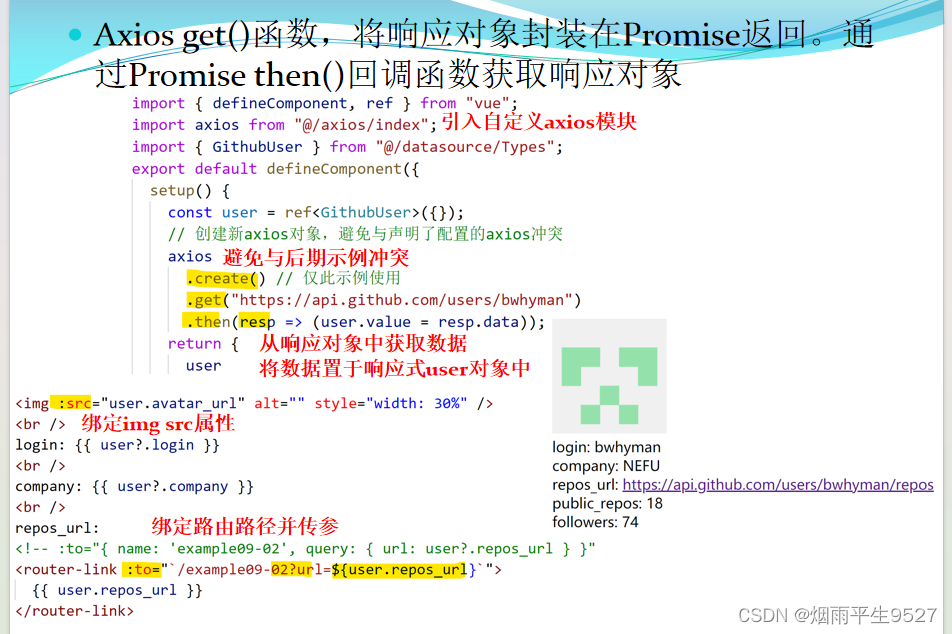

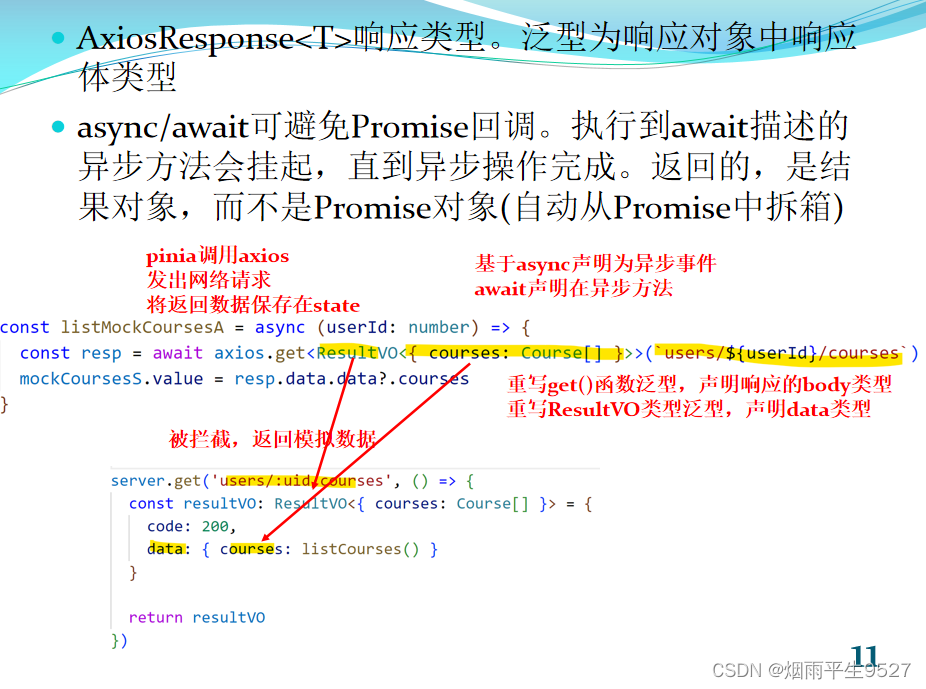 3.3post方法
3.3post方法
post请求常用的数据请求格式有三种:
- Content-Type : application/x-www-form-urlencoded。ajax默认的数据格式。请求体中的数据会以json字符串的形式发送到后端。
- Content-Type : application/json ; charset=utf-8。axios默认的数据格式。请求体中的数据会以普通表单形式(键值对)发送到后端。
- Content-Type : multipart/form-data 。它会将请求体的数据处理为一条消息,以标签为单元,用分隔符分开。既可以上传键值对,也可以上传文件。
Content-Type:application/x-www-form-urlencoded
<script setup>
import axios from 'axios';
import qs from 'qs';
async function sendData() {
const data = { uname: "dingding", upwd: "123456" };
try {
const response = await axios.post("/date.json", qs.stringify({ data }));
console.log("响应:", response);
} catch (error) {
console.error("错误:", error);
}
}
onMounted(() => {
sendData();
});
</script>Content-Type: multipart/form-data(常用于表单提交(图片上传、文件上传))
<script setup>
import axios from 'axios';
// 定义一个异步函数,用于发送数据
async function sendData() {
// 创建所需发送的数据对象
const data = { uname: "dingding", upwd: 123456 };
// 创建一个 FormData 对象用于存储要发送的数据
const formData = new FormData();
// 遍历数据对象的属性,将它们添加到 FormData 对象中
for (const key in data) {
formData.append(key, data[key]);
}
// 打印 FormData 对象,便于调试
console.log(formData);
try {
// 使用 Axios 发起 POST 请求,将 FormData 对象作为请求体
const response = await axios.post("/date.json", formData);
// 打印请求的响应数据
console.log("响应数据:", response.data);
} catch (error) {
// 处理可能出现的错误
console.error("请求错误:", error);
}
}
// 在组件挂载后调用 sendData 函数,确保数据被发送
onMounted(() => {
sendData();
});
</script>
注意:form-data类型的相关请求信息
- 请求地址Request URL: http://localhost:8080/data.json
- 请求头中Content-Type: multipart/form-data; boundary=----WebKitFormBoundarySmuEKOlBaxhc0In2
- 参数形式:{uname: "dingding", upwd: 123456}
Content-Type: application/json(常用)
- 方式一:请求别名的使用
axios.post(url[, data[, config]]) 用于发送数据 `data`对象是作为请求主体被发送的数据
axios发送post无参请求,代码如下:
<script setup>
import axios from 'axios';
// 定义一个异步函数,用于发送 POST 请求
async function sendPostRequest() {
try {
// 使用 Axios 发起 POST 请求,没有请求体
const response = await axios.post("/data.json");
// 打印请求的响应结果
console.log("响应:", response);
} catch (error) {
// 处理可能出现的错误
console.error("请求错误:", error);
}
}
// 在组件挂载后调用 sendPostRequest 函数,确保请求被发送
onMounted(() => {
sendPostRequest();
});
</script>axios发送post有参请求,2种传参形式,代码如下:
① 查询字符串形式
<script setup>
import axios from 'axios';
// 定义一个异步函数,用于发送 POST 请求并携带参数
async function sendPostRequestWithParams() {
try {
// 使用 Axios 发起 POST 请求,请求路径为 "/data.json",请求体为查询字符串 "uname=dingding&upwd=123456"
const response = await axios.post("/data.json", "uname=dingding&upwd=123456");
// 打印请求的响应结果
console.log("响应:", response);
} catch (error) {
// 处理可能出现的错误
console.error("请求错误:", error);
}
}
// 在组件挂载后调用 sendPostRequestWithParams 函数,确保请求被发送
onMounted(() => {
sendPostRequestWithParams();
});
</script>
② 对象形式
<script setup>
import axios from 'axios';
// 定义一个异步函数,用于发送 POST 请求并携带参数
async function sendPostRequestWithJsonParams() {
try {
// 使用 Axios 发起 POST 请求,请求路径为 "/data.json",请求体为 JSON 对象 {uname: "dingding", upwd: 123456}
const response = await axios.post("/data.json", { uname: "dingding", upwd: 123456 });
// 打印请求的响应结果
console.log("响应:", response);
} catch (error) {
// 处理可能出现的错误
console.error("请求错误:", error);
}
}
// 在组件挂载后调用 sendPostRequestWithJsonParams 函数,确保请求被发送
onMounted(() => {
sendPostRequestWithJsonParams();
});
</script>- 方式二:通过向axios传递相关配置来创建请求
<script setup>
import axios from 'axios';
// 定义一个异步函数,用于发送 POST 请求并携带参数
async function sendPostRequestWithParams() {
const data = { uname: "dingding", upwd: 123456 };
try {
// 使用 Axios 发起 POST 请求,请求路径为 "/data.json",请求体为 JSON 对象 {uname: "dingding", upwd: 123456}
const response = await axios.post("/data.json", data);
// 打印请求的响应结果
console.log("响应:", response);
} catch (error) {
// 处理可能出现的错误
console.error("请求错误:", error);
}
}
// 在组件挂载后调用 sendPostRequestWithParams 函数,确保请求被发送
onMounted(() => {
sendPostRequestWithParams();
});
</script>3.4put和patch方法
put和patch请求与post请求用法一样类似,同样有x-www-form-urlencoded、applicition/json和form-data,只有method不同,其他相同。在此不过多赘述了,简单写一下!
<script setup>
import axios from 'axios';
// 定义一个异步函数,用于发送 PUT 请求并携带参数
async function sendPutRequestWithParams() {
const data = { uname: "dingding", upwd: 123456 };
try {
// 使用 Axios 发起 PUT 请求,请求路径为 "/data.json",请求体为 JSON 对象 {uname: "dingding", upwd: 123456}
const putResponse = await axios.put("/data.json", data);
// 打印 PUT 请求的响应结果
console.log("PUT 响应:", putResponse);
} catch (error) {
// 处理可能出现的错误
console.error("PUT 请求错误:", error);
}
}
// 定义一个异步函数,用于发送 PATCH 请求并携带参数
async function sendPatchRequestWithParams() {
const data = { uname: "dingding", upwd: 123456 };
try {
// 使用 Axios 发起 PATCH 请求,请求路径为 "/data.json",请求体为 JSON 对象 {uname: "dingding", upwd: 123456}
const patchResponse = await axios.patch("/data.json", data);
// 打印 PATCH 请求的响应结果
console.log("PATCH 响应:", patchResponse);
} catch (error) {
// 处理可能出现的错误
console.error("PATCH 请求错误:", error);
}
}
// 在组件挂载后分别调用 sendPutRequestWithParams 和 sendPatchRequestWithParams 函数,确保请求被发送
onMounted(() => {
sendPutRequestWithParams();
sendPatchRequestWithParams();
});
</script>
3.5delete方法
axios.delete(url[, config])与axios.get(url[, config])用法基本相似,但是作用不同,它用于删除数据,同get方法一样也可以有几种写法 。
delete请求有时候需要把参数拼接到URL上,有时候像post请求那样把参数放在请求体里面。至于具体怎么调用,需要和后端商量好!
- 方式一:get - params
<script setup>
import axios from 'axios';
// 使用别名法:DELETE 请求携带 params 参数
async function sendDeleteRequestWithParams() {
try {
// 1. 通过 params 对象传递参数
await axios.delete("/data.json", {
params: {
id: 12,
},
}).then((res) => {
console.log(res, "delete (params object)");
});
// 2. 通过查询字符串形式传递参数
await axios.delete("/data.json?id=2", {
params: {
id: 12,
},
}).then((res) => {
console.log(res, "delete (query string)");
});
} catch (error) {
console.error("DELETE 请求错误:", error);
}
}
// 不使用别名法:通过传递相关配置创建 DELETE 请求
async function sendDeleteRequestWithConfig() {
const params = {
id: 5,
};
try {
const response = await axios({
method: "delete",
url: "/data.json",
params: params,
});
console.log(response);
} catch (error) {
console.error("DELETE 请求错误:", error);
}
}
// 在组件挂载后分别调用 sendDeleteRequestWithParams 和 sendDeleteRequestWithConfig 函数,确保请求被发送
onMounted(() => {
sendDeleteRequestWithParams();
sendDeleteRequestWithConfig();
});
</script>- 方式二:post - data
使用类似post请求方式,把axios.delete()中的params改为data,这样请求会把内容放入请求体里面
<script setup>
import axios from 'axios';
// 使用别名法:DELETE 请求携带 data 参数(非标准用法)
async function sendDeleteRequestWithDataAlias() {
try {
const response = await axios.delete("/data.json", {
data: {
id: 5,
},
});
console.log(response, "DELETE with data (using alias)");
} catch (error) {
console.error("DELETE 请求错误(使用别名法):", error);
}
}
// 不使用别名法:通过传递相关配置创建 DELETE 请求并携带 data 参数(非标准用法)
async function sendDeleteRequestWithDataConfig() {
const data = {
id: 5,
};
try {
const response = await axios({
method: "delete",
url: "/data.json",
data: data,
});
console.log(response, "DELETE with data (using config)");
} catch (error) {
console.error("DELETE 请求错误(使用配置法):", error);
}
}
// 在组件挂载后分别调用 sendDeleteRequestWithDataAlias 和 sendDeleteRequestWithDataConfig 函数,确保请求被发送
onMounted(() => {
sendDeleteRequestWithDataAlias();
sendDeleteRequestWithDataConfig();
});
</script>3.6并发请求
`并发请求`: 在同一时间发送多个不同的请求到后端服务,最后同一处理不同服务的响应结果
<script setup>
import axios from 'axios';
// 定义一个异步函数,用于并发请求并处理响应结果
async function handleConcurrentRequests() {
try {
// 同时发起两个 GET 请求
const [dataRes, cityRes] = await Promise.all([
axios.get("/data.json"),
axios.get("/city.json"),
]);
// 打印两个请求的响应结果
console.log("Data Response:", dataRes);
console.log("City Response:", cityRes);
} catch (error) {
// 处理可能出现的错误
console.error("并发请求错误:", error);
}
}
// 在组件挂载后调用 handleConcurrentRequests 函数,确保请求被发送
onMounted(() => {
handleConcurrentRequests();
});
</script>注意:axios.all的参数是请求函数的数组,在对应的回调then中,调用axios.spead对返回值进行处理即可。
并发请求的应用场景:需要同时进行多个请求,并且需要同时处理接口调用的返回值的时候,我们可以使用并发请求。
3.7Restful风格的API
- axios.request(config)
- axios.get(url[, config])
- axios.delete(url[, config])
- axios.head(url[, config])
- axios.post(url[, data[, config]])
- axios.put(url[, data[, config]])
- axios.patch(url[, data[, config]])
<script setup>
import axios from 'axios';
const commonConfig = {
baseURL: 'https://api.example.com/v1',
headers: {
'Content-Type': 'application/json',
Authorization: 'Bearer your-access-token',
},
};
// 示例:使用 axios.request(config)
async function makeRequestUsingRequest() {
const customConfig = {
...commonConfig,
method: 'GET',
url: '/users/123',
};
try {
const response = await axios.request(customConfig);
console.log('axios.request:', response.data);
} catch (error) {
console.error('axios.request Error:', error.message);
}
}
// 示例:使用 axios.get(url[, config])
async function makeGetRequestUsingGetMethod() {
const getEndpoint = '/users/123';
const getConfig = {
...commonConfig,
};
try {
const response = await axios.get(getEndpoint, getConfig);
console.log('axios.get:', response.data);
} catch (error) {
console.error('axios.get Error:', error.message);
}
}
// 示例:使用 axios.head(url[, config])
async function makeHeadRequest() {
const headEndpoint = '/users/123';
const headConfig = {
...commonConfig,
};
try {
const response = await axios.head(headEndpoint, headConfig);
console.log('axios.head:', response.headers); // 注意:HEAD 请求的响应没有 data 属性,仅关注 headers
} catch (error) {
console.error('axios.head Error:', error.message);
}
}
// 在组件挂载后调用各示例函数,确保请求被发送
onMounted(() => {
makeRequestUsingRequest();
makeHeadRequest();
});
</script>3.8响应信息
{
//data是服务器提供的响应
data:{},
//服务器返回的http状态码
status: 200,
//statusText是服务器返回的http状态信息
statusText: 'ok',
//heades是服务器响应中携带的headers
headers:{},
//config是axios进行的设置,目的是为了请求(request)
config:{},
}
//使用then后,response中将包含上述信息
axios.get('/user/12345').then(response={
console.log(response.data);
console.log(response.status);
console.log(response.statusText);
console.log(response.headers);
console.log(response.config);
})
四、Axios进阶用法
4.1axios实例的创建与配置
axios实例的创建
比如:后端接口地址有多个(www.test.com、www.example.com),并且超时时长不同,比如1000ms、2000ms,这个时候,我们可以创建实例,利用axios实例进行网络请求。
思路如下:创建多个实例,配置不同的超时时长,用不同的实例去请求不同的接口。使用axios.acreate来创建实例,配置相关信息,进行网络请求。代码如下:
<script setup>
import axios from 'axios';
// 创建 Axios 实例 1
const instance1 = axios.create({
baseURL: "http://localhost:8080",
timeout: 1000,
});
// 使用实例 1 发送 GET 请求
async function makeRequestUsingInstance1() {
try {
const response = await instance1.get("/data.json");
console.log("Instance 1 Response:", response.data);
} catch (error) {
console.error("Instance 1 Error:", error.message);
}
}
// 创建 Axios 实例 2
const instance2 = axios.create({
baseURL: "http://localhost:8081",
timeout: 2000,
});
// 使用实例 2 发送 GET 请求
async function makeRequestUsingInstance2() {
try {
const response = await instance2.get("/city.json");
console.log("Instance 2 Response:", response.data);
} catch (error) {
console.error("Instance 2 Error:", error.message);
}
}
// 在组件挂载后调用各示例函数,确保请求被发送
onMounted(() => {
makeRequestUsingInstance1();
makeRequestUsingInstance2();
});
</script>备注:此时我们就可以访问http://loacalhost:8080与http://loacalhost:8081两个不同域名的接口,并且使用不同的配置。
axios实例的相关配置
(1)配置列表:
- baseURL:请求的域名 / 基本地址。
- timeout:请求的超时时长,默认:1000毫秒(ms),超过这个时长后端会报(返回)401超时。
- url:请求的路径。
- method:请求的方法。如:get、post、put、patch、delete等。
- headers:请求头。
- params:将请求参数拼接到url上
- data:将请求参数放置到请求体里
let instance = axios.create({
// 创建实例时设置配置默
baseURL: "", //请求的域名/基本地址
timeout: 2000, //请求的超时时长,单位毫秒,默认。
url: "/data.json", //请求路径
method: "get", //请求方法
headers: {
//设置请求头————我们可以给请求头添加一些参数
token: "",
post: {
'Content-Type': 'application/x-www-form-urlencoded;charset=UTF-8'
}
},
params: { id: 5 }, //将请求参数拼接到url上
data: { id: 5 }, //将请求参数放置到请求体里
});(2)三种配置方式:
- axios全局配置
axios.defaults.baseURL = 'http://localhost:8080'
axios.defaults.timeout = 2000备注:在一个项目当中,我们经常存在需要多次请求同一个基本URL下的不同路由,如果每次发送请求都书写一遍基本URL无疑会产生大量的代码重复,因此,可以使用全局配置来简化代码。 默认配置 | Axios 中文文档 | Axios 中文网
- axios实例配置
let instance = axios.create();
instance.defaults.timeout = 3000- axios请求配置
instance.get('/data.json',{
timeout:5000
})配置方式的优先级:axios全局配置 < axios实例配置 < axios请求配置
(3)常用参数配置的使用方法
- 示例1:
let instance1 = axios.create({
baseURL: "http://localhost:9090",
timeout: 1000,
});
instance1
.get("/contactList", {
params: {
id: 5,
},
})
.then((res) => {
console.log(res);
});分析:配置的参数为baseURL:‘http://localhost:8080’,timeout:1000,method:‘get’,params:{ id:10},url:’/contactList’
- 示例2:
let instance2 = axios.create({
baseURL: "http://localhost:8081",
timeout: 3000,
});
instance2
.get("/contactList", {
timeout: 5000,
})
.then((res) => {
console.log(res);
});分析:配置的参数为baseURL:‘http://localhost:8081’,timeout:5000,method:‘get’,url:’/contactList’
注意:最终的有效配置是由优先级高的覆盖优先级低的。
4.2拦截器
何为拦截器?就是在请求前或响应被处理前拦截他们,分为两种:请求拦截器与响应拦截器
(1)axios拦截器的使用方法
- 请求拦截器 ——在请求之前拦截请求
// 添加请求拦截器
/*需要拦截请求的原因
* 1.config中包含了某些不符合服务器要求的信息
* 2.发送网络请求的时候需要向用户展示一些加载中的图标
* 3.网站需要登录才能请求资源,也就是需要token才能请求资源*/
axios.interceptors.request.use(config => {
// 在发送请求之前做些什么
console.log(config)
return config; //拦截器里一定要记得将拦截的结果处理后返回,否则无法进行数据获取
}, err=>{
// 对请求错误做些什么
console.log(err)
return Promise.reject(err) // 在请求错误的时候的逻辑处理
});备注:可以为自定义 axios 实例添加拦截器 👇
var instance = axios.create([config]);
instance.interceptors.request.use(function () {/*...*/});

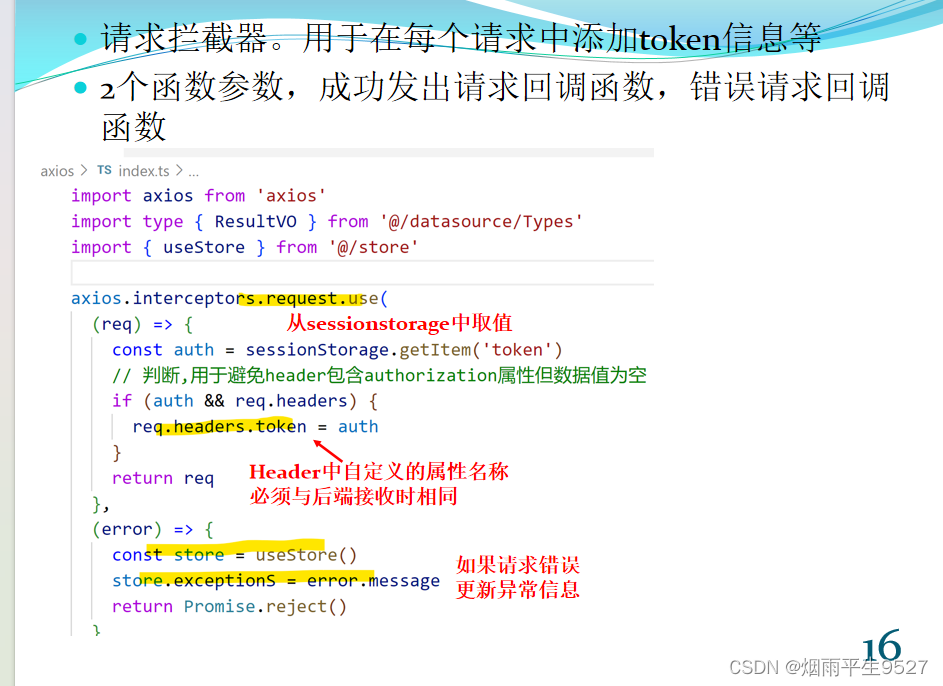
- 响应拦截器 ——在被then,catch处理前拦截响应
// 添加响应拦截器
axios.interceptors.response.use(res => {
// 在请求成功后的数据处理
console.log(res)
return res.data; // 对响应数据做点什么
}, err=>{
// 对响应错误做些什么
console.log(err)
return Promise.reject(err) // 在响应错误的时候的逻辑处理
});
- 取消拦截器(了解)
let inter = axios.interceptors.request.use(config=>{
config.header={
auth:true
}
return config
})
axios.interceptors.request.eject(inter)4.3封装
export function request(config) {
// 1. 创建axios实例
const instance = axios.create({
baseURL: "http://localhost:8080",
timeout: 5000,
});
// 2. axios拦截器的使用
// 2.1 添加请求拦截器
/** 需要拦截请求的原因
* 1.config中包含了某些不符合服务器要求的信息
* 2.发送网络请求的时候需要向用户展示一些加载中的图标
* 3.网站需要登录才能请求资源,也就是需要token才能请求资源
*/
instance.interceptors.request.use(
(config) => {
// 在发送请求之前做些什么
return config; //拦截器里一定要记得将拦截的结果处理后返回,否则无法进行数据获取
},
(err) => {
// 对请求错误做些什么
return Promise.reject(err); // 在请求错误的时候的逻辑处理
}
);
// 2.2 添加响应拦截器
instance.interceptors.response.use(
(res) => {
// 在请求成功后对响应数据做处理
return res; // 对响应数据做点什么
},
(err) => {
// 对响应错误做些什么
return Promise.reject(err); // 在响应错误的时候的逻辑处理
}
);
// 3. 发送网络请求
//axios实例本身返回的就是Promise对象,直接调用即可
return instance(config);
}4.4全局异常信息警告框
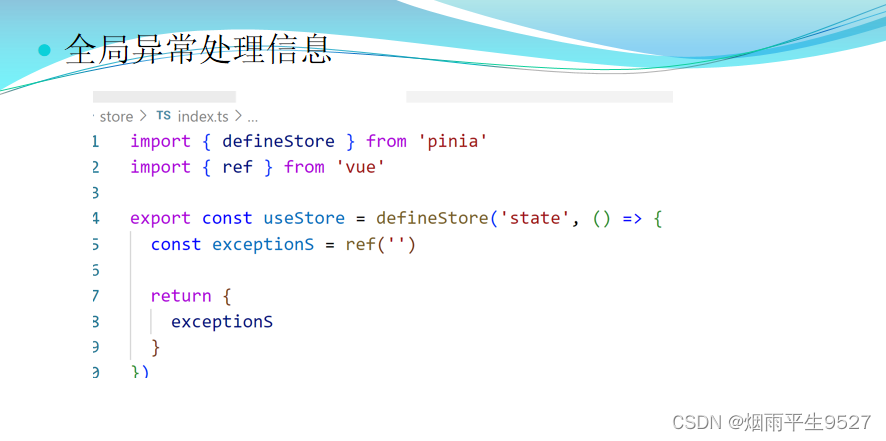
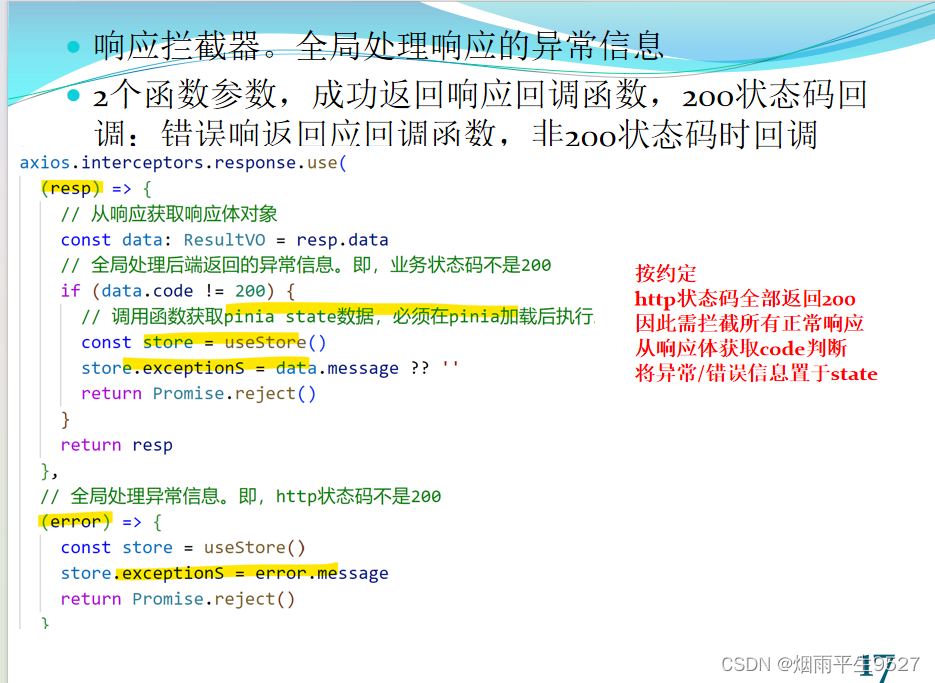
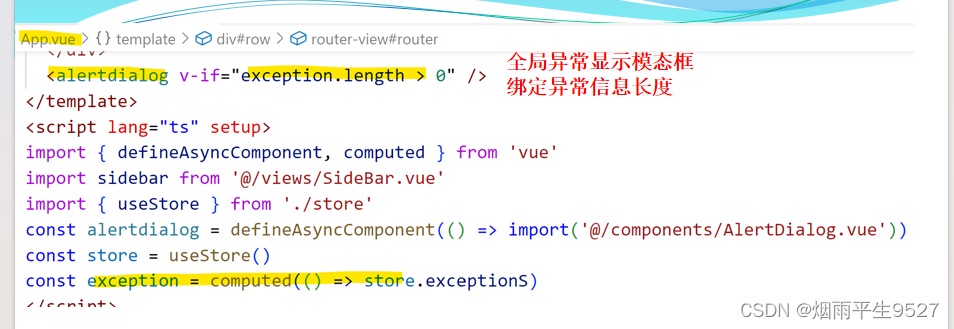
4.5错误处理
结合请求拦截器与响应拦截器来说,不管是请求错误还是响应错误,都会执行catch方法。
(1)请求错误的常见状态码以4开头,如401-请求超时、404-接口未找到;
(2)响应错误的常见状态码以5开头,如500-服务器错误、502-服务器重启等。
// 请求拦截器
axios.interceptors.request.use(
config => {
// 在发送请求前做些什么
return config;
},
err => {
// 在请求错误的时候的逻辑处理
return Promise.reject(err);
}
);
// 响应拦截器
axios.interceptors.response.use(
res => {
// 在请求成功后的数据处理
return res;
},
err => {
// 在响应错误的时候的逻辑处理
return Promise.reject(err);
}
);
axios
.get("/data.json")
.then(res => {
console.log(res);
})
.catch(err => {
console.log(res);
});五、封装
request.js
在项目src目录下新建utils文件夹,然后在其中新建 request.js文件,这个文件是主要书写axios的封装过程。
/**** request.js ****/
// 导入axios
import axios from "axios";
// 使用element-ui Message做消息提醒
import { Message } from "element-ui";
// 1. 创建新的axios实例,
const service = axios.create({
// 公共接口--webpack中的全局变量process.env.BASE_API
// 为了适应多个后台或者开发的时候的api地址和发布的时候的api地址不一样这种情况
baseURL: process.env.BASE_API,
// 超时时间 单位是ms,这里设置了3s的超时时间
timeout: 3 * 1000,
});
// 2. 请求拦截器
service.interceptors.request.use(
(config) => {
// 发请求前做的一些处理,数据转化,配置请求头,设置token,设置loading等,根据需求去添加
config.data = JSON.stringify(config.data); // 数据转化,也可以使用qs转换
config.headers = {
"Content-Type": "application/x-www-form-urlencoded", // 配置请求头
};
//注意使用token的时候需要引入cookie方法或者用本地localStorage等方法,推荐js-cookie
const token = getCookie("名称"); // 这里取token之前,你肯定需要先拿到token,存一下
if (token) {
config.params = { token: token }; // 如果要求携带在参数中
config.headers.token = token; // 如果要求携带在请求头中
}
return config;
},
(error) => {
Promise.reject(error);
}
);
// 3. 响应拦截器
service.interceptors.response.use(
(response) => {
//接收到响应数据并成功后的一些共有的处理,关闭loading等
return response;
},
(error) => {
/* **** 接收到异常响应的处理开始 **** */
if (error && error.response) {
// 1. 公共错误处理
// 2. 根据响应码具体处理
switch (error.response.status) {
case 400:
error.message = "错误请求";
break;
case 401:
error.message = "未授权,请重新登录";
break;
case 403:
error.message = "拒绝访问";
break;
case 404:
error.message = "请求错误,未找到该资源";
window.location.href = "/NotFound";
break;
case 405:
error.message = "请求方法未允许";
break;
case 408:
error.message = "请求超时";
break;
case 500:
error.message = "服务器端出错";
break;
case 501:
error.message = "网络未实现";
break;
case 502:
error.message = "网络错误";
break;
case 503:
error.message = "服务不可用";
break;
case 504:
error.message = "网络超时";
break;
case 505:
error.message = "http版本不支持该请求";
break;
default:
error.message = `连接错误${error.response.status}`;
}
} else {
// 超时处理
if (JSON.stringify(error).includes("timeout")) {
Message.error("服务器响应超时,请刷新当前页");
}
error.message("连接服务器失败");
}
Message.error(error.message);
/* **** 处理结束 **** */
// 如果不需要错误处理,以上的处理过程都可省略
return Promise.resolve(error.response);
}
);
// 4. 导入文件
export default service;Axios中的http.js
在项目src目录下的utils文件夹中新建 http.js文件,这个文件是主要书写几种请求方式的封装过程。
// api.js有两种导出方式,分类导出和全部导出
// 分类导出
import http from '../utils/http'
/**
* @params resquest 请求地址 例如:http://197.82.15.15:8088/request/...
* @param '/testIp'代表vue-cil中config,index.js中配置的代理
*/
let resquest = "/testIp/request/"
// get请求
export function getListAPI(params){
return http.get(`${resquest}/getList.json`,params)
}
// post请求
export function postFormAPI(params){
return http.post(`${resquest}/postForm.json`,params)
}
// put 请求
export function putSomeAPI(params){
return http.put(`${resquest}/putForm.json`,params)
}
// delete 请求
export function deleteListAPI(params){
return http.delete(`${resquest}/deleteList.json`,params)
}
// 全部导出
import http from '../utils/http'
/**
* @params resquest 请求地址 例如:http://197.82.15.15:8088/request/...
* @param '/testIp'代表vue-cil中config,index.js中配置的代理
*/
let resquest = "/testIp/request/"
// get请求
export default{
getListAPI(params){
return http.get(`${resquest}/getList.json`,params)
},
postFormAPI(params){
return http.post(`${resquest}/postForm.json`,params)
},
putFormAPI(params){
return http.put(`${resquest}/putForm.json`,params)
},
deleteListAPI(params){
return http.delete(`${resquest}/deleteList.json`,params)
}
}调用
// 把api分类导入,用到哪个api 就调用哪个接口 ————适用于上面接口的分类导出
import {getListAPI,postFormAPI, putSomeAPI, deleteListAPI} from '@/api/api'
methods: {
// promise调用,链式调用, getList()括号内只接受参数;
// get不传参
getList() {
getListAPI().then(res => console.log(res)).catch(err => console.log(err))
},
// post传参
postForm(formData) {
let data = formData
postFormAPI(data).then(res => console.log(res)).catch(err => console.log(err))
},
// async await同步调用
async postForm(formData) {
const postRes = await postFormAPI(formData)
const putRes = await putSomeAPI({data: 'putTest'})
const deleteRes = await deleteListAPI(formData.name)
// 数据处理
console.log(postRes);
console.log(putRes);
console.log(deleteRes);
},
}
// 把api全部导入,然后用到哪个api调用哪个api ————适用于全部导出
import api from '@/api/api'
methods: {
getList() {
api.getListAPI(data).then(res => {
// 数据处理
}).catch(err => console.log(err))
}
} 



